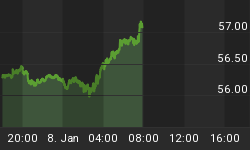On April 20th, Bank of America announced a first quarter surge in earnings to $4.2 billion. At first blush, it looked like the kind of news that would ignite a stock market rally. Instead, the Dow closed down 289 points. Could it be that, despite the apparent good news, investors don't trust the banks or the economy?
In recent months, the Administration has poured billions of dollars into those banks that it has deemed "too big to fail". B of A alone received some $45 billion. Perhaps now it is time to examine whether the liabilities of these same banks make them, conversely, too big to survive.
Importantly, B of A's sale of China Construction Bank, a much-prized future earner, resulted in a one-time-only earnings contribution of $1.9 billion, or 45 percent of their just posted quarterly profit figure.
In addition, $2.2 billion in gains were contributed by certain mark-to-market bank "adjustments" to Merrill Lynch's structured notes. These gains appear to be the result of recent changes in the accounting rules that now allow banks to "officially" inflate the value of toxic assets and thereby erase billions of dollars of paper losses.
In short, the so-called surge in the earnings of Bank of America had little to do with real, repeatable earnings, and much to do with sales of promising assets and accounting gimmickry.
To be fair, in announcing the earnings surge, B of A CEO Ken Lewis admitted that his company continued to face, "extremely difficult challenges primarily from deteriorating credit quality driven by weakness in the economy and growing unemployment." Although it glossed over the poor quality of his bank's recent earning increase, it was a partial admission of problems ahead for the whole banking industry. It sparked a renewed awareness that the banks face some lasting problems.
American investors are becoming increasingly aware of internal flaws in our economy. Ignoring Administration and Wall Street entreaties to continue spending, consumers are deleveraging and saving cash. There is evidence that Americans are staying at home more, especially for eating and entertainment, and are undertaking more do-it-yourself repairs. Airlines, movie theaters, and restaurants are all experiencing reduced turnover. After a year of bad economic news, Americans are less susceptible to rosy financial reporting from discredited banks.
Already, U.S. unemployment stands officially at 8.7 percent. However, if it is calculated by the pre-Clinton method to include those who have been unemployed for longer than one year, those who have been forced to accept part-time employment, and those who have given up seeking re-employment, the figure stands at 19.2 percent, or just 0.8 percent below Great Depression levels!
The outlook for both corporate and individual loan defaults is appalling. Already, mortgage defaults are exploding. They now extend to the commercial sector and into the retail prime and jumbo mortgage markets.
Many can now clearly see that the outlook for both corporate and individual loan defaults is appalling. Already, mortgage defaults are exploding. They now extend to the commercial sector and into the retail prime and jumbo mortgage markets. The greatly undercapitalized banks face huge increases in loan defaults in almost every sector, which will deplete future earnings and further threaten capital solvency.
But all this is dwarfed by the exposure of the major money center banks to the vast $418 trillion American share of the derivatives markets and, in particular, to the risks posed by counterparty defaults in so-called Credit Default Swaps. These are massive in relation to the banks' capital reserves.
For example, the combined capital of just five of the top 14 largest American banks would be overexposed to derivative default risk by between 200 and 1,000 times. Up to now, this shocking figure was largely concealed or deliberately ignored by politicians and Wall Street analysts, who were naturally frightened by what they saw.
Despite this financial minefield, the stock prices of financials have rallied strongly. Perversely, many seemingly high risk companies like Citigroup have seen their shares climb by over 100 percent from their lows, while those with little debt have underperformed by some 50 percent.
One reason for this strange market behavior may be the perception that the money center banks are "too big to fail" and will be bailed out by taxpayers. In reality, however big the banks, even with government guarantees, the problems they face appear too big to survive.
For a more in-depth analysis of our financial problems and the inherent dangers they pose for the U.S. economy and U.S. dollar, read Peter Schiff's newest book "The Little Book of Bull Moves in Bear Markets." Click here to order your copy now.
For a look back at how Peter predicted our current problems read the 2007 bestseller "Crash Proof: How to Profit from the Coming Economic Collapse." Click here to order a copy today.
More importantly, don't wait for reality to set in. Protect your wealth and preserve your purchasing power before it's too late. Discover the best way to buy gold at www.goldyoucanfold.com. Download Euro Pacific's free Special Report, "Peter Schiff's Five Favorite Investment Choices for the Next Five Years", at http://www.europac.net/report/index_fivefavorites.asp. Subscribe to our free, on-line investment newsletter, "The Global Investor" at http://www.europac.net/newsletter/newsletter.asp. And now watch the latest episode of Peter's new video blog, "The Schiff Report", at http://www.europac.net/videoblog.asp.
















